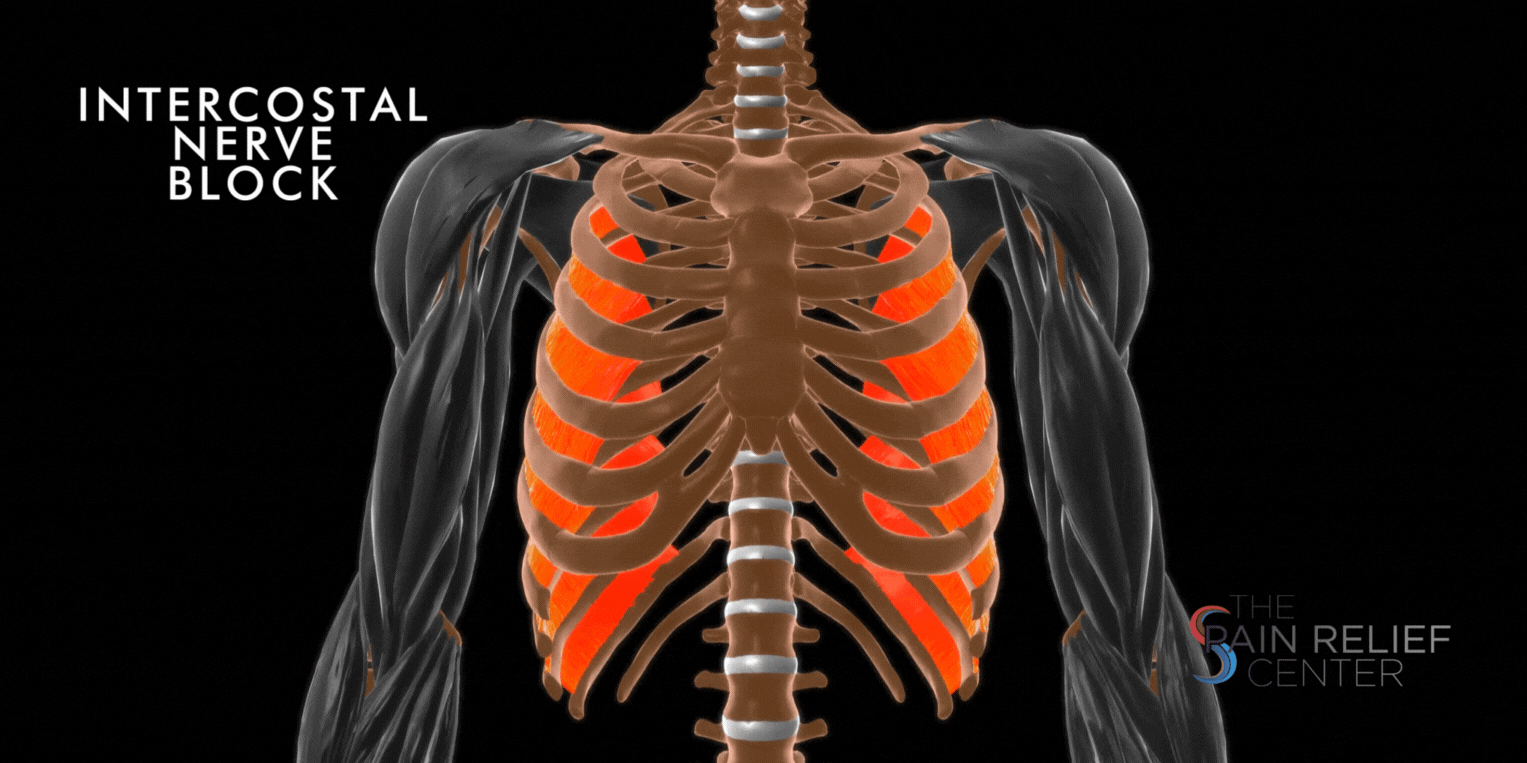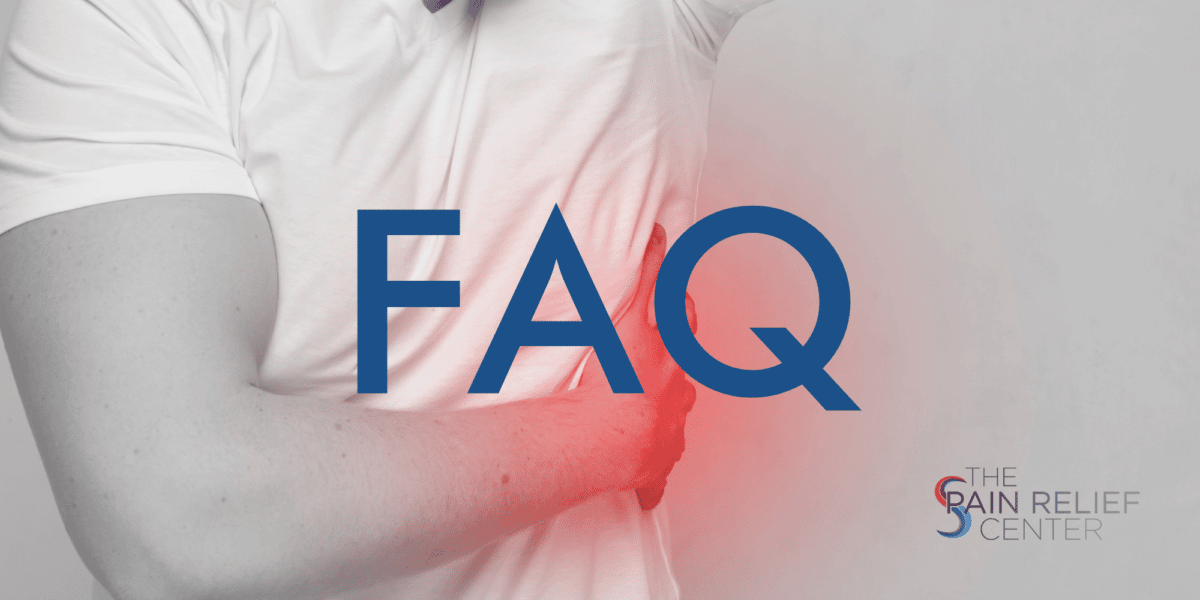INTERCOSTAL NERVE BLOCK
Intercostal Nerve Block Treatment in Plano, Texas
Home » Treatments » Intercostal Nerve Block
TREATMENT OPTIONS
What is an Intercostal Nerve Block?

Who Can Benefit From Intercostal Nerve Blocks?
Intercostal nerve blocks, or ICNB, are used for both therapeutic and diagnostic purposes. They manage acute pain and chronic pain in the chest area.
The most common use of ICNB is to provide analgesia for patients with rib fractures and for postoperative pain after a check or upper abdominal surgery, such as a thoracostomy, thoracotomy, mastectomy, cholecystectomy, or gastrostomy. Patients typically show improvements for respiratory function and pain relief.
Intercostal nerve blocks do not block visceral abdominal pain. For this, patients would need a celiac plexus block.
Neurolytic intercostal nerve blocks are used to manage chronic pain associated with the postoperative pain of mastectomy and thoracotomy procedures.
Indications include:
- Analgesia for thoracostomy
- Breast surgery
- Chest wall trauma
- Differentiating between visceral pain and somatic pain
- Herpes zoster infection, postherpetic neuralgia, Shingles
- Incisional pain in the chest from thoracic surgery
- Rib fractures, especially for multiple fractured ribs
- Upper abdominal surgery
Anatomy of Intercostal Nerves

Twelve intercostal nerves supply our sensory innervation for the major parts of our back, trunk, and upper abdomen. They also supply the muscular innervation for our intercostal muscles.
Every intercostal nerve starts from the spinal nerve roots that are the same vertebral level as the specific rib they travel alongside.
As the spinal nerve emerges from your spinal cord, the nerve immediately divides into your dorsal and ventral branches:
- The dorsal nerve branch supplies your motor and sensory innervation of your paravertebral musculature, overlying skin, and subcutaneous tissue
- The ventral branch continues anterolaterally, becoming the intercostal nerve
Every intercostal nerve travels within a neurovascular bundle. This bundle accounts for any high level of local anesthetic uptake into the blood after an intercostal nerve block.
Near the midaxillary line, your intercostal nerve sends an offshoot, or lateral cutaneous branch. This travels laterally through your internal costal muscles and external costal muscles until it divides into a dorsal and ventral branch. This innervates the skin and subcutaneous tissue of your lateral trunk and upper abdomen.
Right before your individual intercostal nerves decease, they send the anterior cutaneous branch, which then divides into a lateral branch and a medial branch. This supplies both the skin and the subcutaneous tissue of your anterior trunk and abdomen, which includes the skin over your sternum and rectus abdominis.
What Happens During an Intercostal Nerve Block Procedure?
At the Pain Relief Center in Plano, Texas, we administer intercostal nerve blocks with extreme care. While this isn’t a risky procedure, we do like to take the necessary precautions for our patients’ safety.
- First, the patient is given intravenous medication to help them relax.
- Then, he or she will lie on the side that isn’t causing intercostal nerve pain.
- From here, our Plano pain relief specialist will use an antiseptic to clean the area of skin near the injection site.
- Next, our pain relief doctor will insert a very thin needle under the patient’s rib and inject an anesthetic.
- Our pain management specialist will then use x-ray guidance to insert a second need to insert a contrast agent to verify where the injection is going.
- Once the injection’s path has been verified by the x-ray, our pain management physician will administer the steroid medication into the chest wall.
In general, the injection is administered while the patient lies on his or her stomach with their arms stretched upward. At the Pain Relief Center, we monitor the patient’s blood pressure and oxygen levels the entire time.
In addition to our Plano pain management physician, there will also be an x-ray technician to assist in x-ray guidance, as well as a nurse or medical assistant in the room at all times.
How Long Does an Intercostal Nerve Block Take?
The entire intercostal nerve block procedure usually takes less than 30 minutes to an hour, and patients can return home the same day.
The actual injection only takes a couple of minutes. But, patients should allow more time to speak with our Plano pain relief doctor, sign the informed consent forms, and for recovery observation after the procedure.
Post Intercostal Nerve Block Procedure
Our Plano pain management specialists will go over all of the postoperative care instructions with you in the office. For most patients, we recommend that they not drive, operate heavy machinery, or participate in any rigorous activity for the next 24 hours after they receive the intercostal nerve block.
Immediately following the intercostal block procedure, the patient is kept in our recovery room for a short amount of time (generally 20 minutes) so that he or she can be monitored by a nurse. In extremely rare cases, the injection can cause a complication called a pneumothorax, which is essentially a collapsed lung. Our nurse also monitors the patient for complications that can occur after any procedure, such as local anesthetic toxicity, hematoma, and spinal anesthesia. Some patients may require a chest x-ray before they leave, just to be sure everything is normal, as a precaution.
Patients may take their regular medications and continue their regular diets the same day.
Risks of Intercostal Nerve Blocks
All procedures carry some form of risk. The risk of complication for an intercostal nerve block is low. Some patients may have bruises or soreness at the injection site.
Rare but serious complications include:
- infection
- collapsed lung
- nerve damage
- internal bleeding
- inadvertent puncture of the “sack” that contains spinal fluid (This may cause headaches.)
Intercostal Nerve Block FAQs

How Effective is an Intercostal Nerve Block for Pain Relief?
Many patients report immediate pain relief after the intercostal nerve injection. However, the pain may return after the local anesthetic wears off. The longer-term intercostal nerve pain should subside in 2 or 3 days, as the steroid starts to work.
How Long Does an Intercostal Nerve Block Work?
The amount of time the pain relief lasts is different for every patient. For many, the chest wall pain subsides for several months. Patients who find the intercostal nerve block treatment effective can receive periodic injections to remain pain-free!
Do Intercostal Nerve Blocks Hurt?
At The Pain Relief Center, we inject a small amount of local anesthetic through a small needle. For most patients, this feels like a tiny sting, followed by a slight burning sensation as the local anesthetic starts to numb the skin.
After your skin is numb, the needle containing the steroid may cause slight pressure at the injection site. Many patients won’t feel anything after the first injection.
Will I Be Under General Anesthesia or Receive a Local Anesthetic for an Intercostal Nerve Block?
The choice is yours. Patients can choose to have intercostal blocks administered under a local anesthetic only. Or, they may choose to do so under an IV sedation. For some patients, the sedation causes drowsiness, while other patients have little to no memory of the procedure.
Can I Have More Than One Intercostal Nerve Block Injection?
If the first injection is successful but the pain in the chest returns, you may be eligible for more than one injection. We typically only allow this if the patient had relief from pain in the chest wall for a reasonable period of time. This varies on a case by case basis.
Who Should Not Get Intercostal Nerve Block Injections?
Patients should not get the injection if he or she is allergic to any of the medications that are injected, including the local anesthetic required, if they are on a blood thinner, such as Coumadin or Injectable Heparin, or if they have an active infection.
For patients taking blood thinners, we may advise you to stop taking your medicine a few days beforehand or recommend a “bridge therapy” with Lovenox before we inject the internal intercostal muscle. Patients who take antiplatelet medicines, such as Plavix, must stop taking these medications at least 5 days before the procedure.
TAKE ACTION
The most critical step on the path to recovery is finding a pain management doctor who can address your pain management needs successfully. The Pain Relief Center and its five specialized institutes are dedicated to meeting any and all of a patient’s needs. Located in the Dallas-Fort Worth area, Dr. Rodriguez and his friendly staff will help you along the path to recovery.
Our new center in Dallas is part of a nationwide development by Pain Relief Centers, geared to providing individualized and comprehensive healing and pain management services with unprecedented levels of compassion, care, and comfort for each patient.

